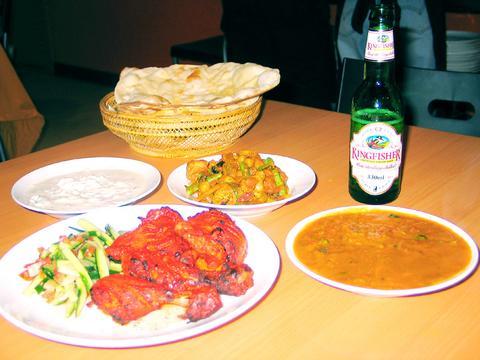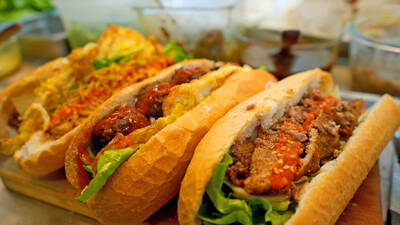Born and raised in India, Daniel Hsiung (熊懌騰) originally came to Taiwan to study Chinese cooking. After finishing cooking school and a few stints in various pub kitchens, Hsiung abandoned Chinese cuisine in favor of his native fare and opened The Spice Shop.
A fourth-generation Indo-Chinese, Hsiung is not the only member of his family to find success in the Indian restaurant business. In fact this is the sixth Spice Shop to open in Taiwan, as two cousins own and operate a total of five restaurants in Kaoshiung, Taichung and Hsinchu.

PHOTO: DIANA FREUNDL, TAIPEI TIMES:
Offering a large selection of vegetarian and non-vegetarian dishes, The Spice Shop serves up curry favorites such as beef madras (beef in coconut sauce), chicken tikka masala, mutton bhuna (mutton with onion and pepper) and others priced under NT$300 each. The most popular and highly recommended dish is the chicken tandoori (NT$300), served with a small side of kuchember (spicy Indian salad).
The vegetarian selection is equally plentiful and tasty. Made with seasonal vegetables the jhalfraizie (NT$180) is a refreshing change from the frozen veggies often used in mixed curry. Channa masala (chickpea curry), palak paneer (made with spinach and homemade cheese) and the daal all come highly recommended at NT$180.
Diners looking to satisfy a sweet craving after their curry will have to settle on a lassi, as there are no desserts on the menu. The mango lassi, made with fresh mango and yogurt, however, should not be overlooked.
The restaurant's decor remains debatable with a limited (yet eye-catching) selection of Indian tapestries hanging on exceptionally bright orange walls, with spindly chip board tables and plastic chairs.
A trained chef, Hsiung says he still prefers to be in the kitchen and still does most of the cooking. Apart from using less oil and chili, which can be increased on request, Hsiung claims he doesn't cater to Chinese or Western tastes, and instead prepares the food exactly as he would in India.
In less than two years since opening, The Spice Shop has acquired a substantial number of regulars who fill the tiny establishment nightly. With a maximum seating capacity of 40 persons, the restaurant fills up early, so reservations are not a bad idea, especially on the weekends.
Even at full capacity the wait for food is not intolerable and rather enjoyable with a selection of beers that includes India's own, King Fisher. Alternatively, patrons can bring their own bottle of wine, but are required to pay a NT$200 corkage charge.

We lay transfixed under our blankets as the silhouettes of manta rays temporarily eclipsed the moon above us, and flickers of shadow at our feet revealed smaller fish darting in and out of the shelter of the sunken ship. Unwilling to close our eyes against this magnificent spectacle, we continued to watch, oohing and aahing, until the darkness and the exhaustion of the day’s events finally caught up with us and we fell into a deep slumber. Falling asleep under 1.5 million gallons of seawater in relative comfort was undoubtedly the highlight of the weekend, but the rest of the tour

Youngdoung Tenzin is living history of modern Tibet. The Chinese government on Dec. 22 last year sanctioned him along with 19 other Canadians who were associated with the Canada Tibet Committee and the Uighur Rights Advocacy Project. A former political chair of the Canadian Tibetan Association of Ontario and community outreach manager for the Canada Tibet Committee, he is now a lecturer and researcher in Environmental Chemistry at the University of Toronto. “I was born into a nomadic Tibetan family in Tibet,” he says. “I came to India in 1999, when I was 11. I even met [His Holiness] the 14th the Dalai

Following the rollercoaster ride of 2025, next year is already shaping up to be dramatic. The ongoing constitutional crises and the nine-in-one local elections are already dominating the landscape. The constitutional crises are the ones to lose sleep over. Though much business is still being conducted, crucial items such as next year’s budget, civil servant pensions and the proposed eight-year NT$1.25 trillion (approx US$40 billion) special defense budget are still being contested. There are, however, two glimmers of hope. One is that the legally contested move by five of the eight grand justices on the Constitutional Court’s ad hoc move

Stepping off the busy through-road at Yongan Market Station, lights flashing, horns honking, I turn down a small side street and into the warm embrace of my favorite hole-in-the-wall gem, the Hoi An Banh Mi shop (越南會安麵包), red flags and yellow lanterns waving outside. “Little sister, we were wondering where you’ve been, we haven’t seen you in ages!” the owners call out with a smile. It’s been seven days. The restaurant is run by Huang Jin-chuan (黃錦泉), who is married to a local, and her little sister Eva, who helps out on weekends, having also moved to New Taipei